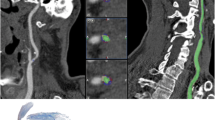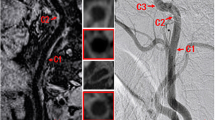Abstract
The diagnostic imaging techniques currently used to evaluate the arterial atherosclerosis hinge on the manual marking and calculation of the stenosis degree. However, the manual assessment is highly dependent on the operator and characterized by low replicability. The study aimed to develop a fully-automated tool for the segmentation and analysis of atherosclerosis in the extracranial carotid arteries. The dataset consisted of 59 randomly-chosen individuals who had undergone head-and-neck computed tomography angiography (CTA), at the Tampere University Hospital, Tampere, Finland. The analysis algorithm was mainly based on the detection of carotid arteries, delineation of the vascular wall, and extraction of the atherosclerotic plaque. To improve the vascular detection rate, the model-based and volume-wide analytical approaches were deployed. A new fully-automated vascular imaging (VASIM) software tool was developed. For stenosis over 50%, the success rate was 83% for the detection and segmentation. Specificity and sensitivity of the algorithm were 25% and 83%, respectively. The overall accuracy was 71%. The VASIM tool is the first published approach for the fully-automated analysis of atherosclerosis in extracranial carotid arteries. The tool provides new outputs, which may help with the quantitative and qualitative, clinical evaluation of the atherosclerosis burden and evolution. The findings from this study provide a basis for the further development of automated atherosclerosis diagnosis and plaque analysis with CTA.





Similar content being viewed by others
Abbreviations
- CCA:
-
Common carotid artery
- CT:
-
Computed tomography
- CTA:
-
Computed tomography angiography
- CVAs:
-
Cerebrovascular accidents
- CVDs:
-
Cardiovascular diseases
- ECA:
-
External carotid artery
- HU:
-
Hounsfield unit
- ICA:
-
Internal carotid artery
- MRI:
-
Magnetic resonance imaging
- NASCET:
-
North American Symptomatic Carotid Endarterectomy Trial
- SD:
-
Standard deviation
- TAYS:
-
Tampere University Hospital
- VASIM:
-
Vascular imaging
References
Beevers DG (2005) The atlas of heart disease and stroke. J Hum Hypertens 19(6):505–505
Strong K, Mathers C, Bonita R (2007) Preventing stroke: saving lives around the world. Lancet Neurol 6(2):182–187
Lusis AJ (2000) Atherosclerosis. Nature 407:233
Enterline DS, Kapoor G (2006) A practical approach to CT angiography of the neck and brain. Tech Vasc Interv Radiol 9(4):192–204
Vukadinovic D, van Walsum T, Manniesing R, Rozie S, Hameeteman R, de Weert TT, van der Lugt A, Niessen WJ (2010) Segmentation of the outer vessel wall of the common carotid artery in CTA. IEEE Trans Med Imaging 29(1):65–76
dos Santos FL, Joutsen A, Terada M, Salenius J, Eskola H (2014) A semi-automatic segmentation method for the structural analysis of carotid atherosclerotic plaques by computed tomography angiography. J Atheroscler Thromb 21(9):930–940
Gates L, Indes J (2014) Evaluation and treatment of carotid artery stenosis. In: Gates L, Indes J (eds) Carotid artery disease—from bench to bedside and beyond. IntechOpen, London
Markiewicz T, Dziekiewicz M, Maruszyński M, Bogusławska-Walecka R, Kozłowski W (2014) Recognition of atherosclerotic plaques and their extended dimensioning with computerized tomography angiography imaging. Int J Appl Math Comput Sci 24(1):33–47
Dos Santos FL, Joutsen A, Paci M, Salenius J, Eskola H (2016) Automatic detection of carotid arteries in computed tomography angiography: a proof of concept protocol. Int J Cardiovasc Imaging 32(8):1299–1310
de Weert TT, de Monye C, Meijering E, Booij R, Niessen WJ, Dippel DW, van der Lugt A (2008) Assessment of atherosclerotic carotid plaque volume with multidetector computed tomography angiography. Int J Cardiovasc Imaging 24(7):751–759
Ferguson GG, Eliasziw M, Barr HW, Clagett GP, Barnes RW, Wallace MC, Taylor DW, Haynes RB, Finan JW, Hachinski VC et al (1999) The North American symptomatic carotid endarterectomy trial: surgical results in 1415 patients. Stroke 30(9):1751–1758
Dos Santos FLC, Joutsen A, Salenius J, Eskola H (2014) Fusion of edge enhancing algorithms for atherosclerotic carotid wall contour detection in computed tomography angiography. Comput Cardiol 41:925–928
Lee TC, Kashyap RL, Chu CN (1994) Building skeleton models via 3-D medial surface axis thinning algorithms. CVGIP: Gr Models Image Process 56(6):462–478
Otsu N (1979) A threshold selection method from gray-level histograms. IEEE Trans Syst Man Cybern 9(1):62–66
Aboyans V, Ricco JB, Bartelink MEL, Bjorck M, Brodmann M, Cohnert T, Collet JP, Czerny M, De Carlo M, Debus S et al (2018) Editor’s Choice—2017 ESC guidelines on the diagnosis and treatment of peripheral arterial diseases, in collaboration with the European Society for vascular surgery (ESVS). Eur J Vasc Endovasc Surg 55(3):305–368
Santos F, Joutsen A, Salenius J, Eskola H (2011) Carotid artery atherosclerosis plaque analysis using ct and histology. In: Computational vision and medical image processing VIPIMAGE 2011—III ECCOMAS thematic conference on computational vision and medical image processing, Olhao, Algarve, Portugal, 12–14 October, 2011, CRS Press, Boca Raton pp 1–5
Hoh DJ, Maya M, Jung A, Ponrartana S, Lauryssen CL (2008) Anatomical relationship of the internal carotid artery to C-1: clinical implications for screw fixation of the atlas. J Neurosurg Spine 8(4):335–340
Zarins CK, Giddens DP, Bharadvaj BK, Sottiurai VS, Mabon RF, Glagov S (1983) Carotid bifurcation atherosclerosis. Quantitative correlation of plaque localization with flow velocity profiles and wall shear stress. Circ Res 53(4):502–514
Kwak HS, Yang HJ, Hwang SB, Chung GH (2017) Carotid wall imaging with routine brain MRI to facilitate early detection of carotid plaque and intraplaque hemorrhage. J Stroke 19(1):107–108
van Hoof RHM, Voo SA, Sluimer JC, Wijnen NJA, Hermeling E, Schreuder F, Truijman MTB, Cleutjens JPM, Daemen M, Daemen JH et al (2017) Vessel wall and adventitial DCE-MRI parameters demonstrate similar correlations with carotid plaque microvasculature on histology. J Magn Reson Imaging 46(4):1053–1059
Randoux B, Marro B, Koskas F, Duyme M, Sahel M, Zouaoui A, Marsault C (2001) Carotid artery stenosis: prospective comparison of CT, three-dimensional gadolinium-enhanced MR, and conventional angiography. Radiology 220(1):179–185
Jodas DS, Pereira AS, JM RST (2016) Lumen segmentation in magnetic resonance images of the carotid artery. Comput Biol Med 79:233–242
Augst AD, Ariff B, Mc GTSA, Xu XY, Hughes AD (2007) Analysis of complex flow and the relationship between blood pressure, wall shear stress, and intima-media thickness in the human carotid artery. Am J Physiol Heart Circ Physiol 293(2):H1031–H1037
Cheng DC, Billich C, Liu SH, Brunner H, Qiu YC, Shen YL, Brambs HJ, Schmidt-Trucksass A, Schutz UH (2011) Automatic detection of the carotid artery boundary on cross-sectional MR image sequences using a circle model guided dynamic programming. Biomed Eng Online 10(1):26
Acharya UR, Sree SV, Mookiah MR, Saba L, Gao H, Mallarini G, Suri JS (2013) Computed tomography carotid wall plaque characterization using a combination of discrete wavelet transform and texture features: a pilot study. Proc Inst Mech Eng H 227(6):643–654
Ambale-Venkatesh B, Yang X, Wu Colin O, Liu K, Hundley WG, McClelland R, Gomes Antoinette S, Folsom Aaron R, Shea S, Guallar E et al (2017) Cardiovascular event prediction by machine learning. Circ Res 121(9):1092–1101
Menchón-Lara R-M, Sancho-Gómez J-L (2015) Fully automatic segmentation of ultrasound common carotid artery images based on machine learning. Neurocomputing 151:161–167
Menchón-Lara R-M, Sancho-Gómez J-L, Bueno-Crespo A (2016) Early-stage atherosclerosis detection using deep learning over carotid ultrasound images. Appl Soft Comput 49:616–628
Nikan S, Gwadry-Sridhar F, Bauer M (2016) Machine learning application to predict the risk of coronary artery atherosclerosis. In: 2016 International conference on computational science and computational intelligence (CSCI): 15–17 Dec. 2016, pp 34–39
Acknowledgements
The authors would like to thank Raija Paalavuo RN, Anna-Kaisa Parkkila MD, and Ullamari Hakulinen Lic.Sc., Med. Phys. for their help with patient recruitment and management.
Funding
FLCS was supported by the CIMO Foundation (Centre for International Mobility; KM-12-8107), Tampere University Hospital, and an iBioMEP doctoral scholarship. MP was supported by the Finnish Cultural Foundation (Central Fund, Grant No. 160735) and by the Academy of Finland (decision number 307967). The project was also partly supported by the Competitive State Research Financing of the Expert Responsibility Area of Tampere University Hospital (Grant No. R07210/ 9K115).
Author information
Authors and Affiliations
Contributions
All authors declare they have contributed to this article. FLCS was responsible for defining the study objectives and design, data collection, development of the image processing and segmentation algorithms, analysis of the data, and statistical analysis. MK was responsible for data collection from the patients files information and stenosis manual calculation. FLCS wrote the manuscript and the co-authors MK, MT, JS, HE, and MP reviewed, commented, and improved the text.
Corresponding author
Ethics declarations
Conflict of interest
The authors declare that they have no conflict of interest.
Ethical approval
All procedures performed in studies involving human participants were in accordance with the ethical standards of the institutional and/or national research committee and with the 1964 Helsinki declaration and its later amendments or comparable ethical standards. This research was approved by the Ethics Committee of the Pirkanmaa Hospital District (decision number R07210).
Informed consent
Informed consent was obtained from all individual participants included in the study.
Additional information
Publisher’s Note
Springer Nature remains neutral with regard to jurisdictional claims in published maps and institutional affiliations.
Rights and permissions
About this article
Cite this article
Caetano dos Santos, F., Kolasa, M., Terada, M. et al. VASIM: an automated tool for the quantification of carotid atherosclerosis by computed tomography angiography. Int J Cardiovasc Imaging 35, 1149–1159 (2019). https://doi.org/10.1007/s10554-019-01549-1
Received:
Accepted:
Published:
Issue Date:
DOI: https://doi.org/10.1007/s10554-019-01549-1




